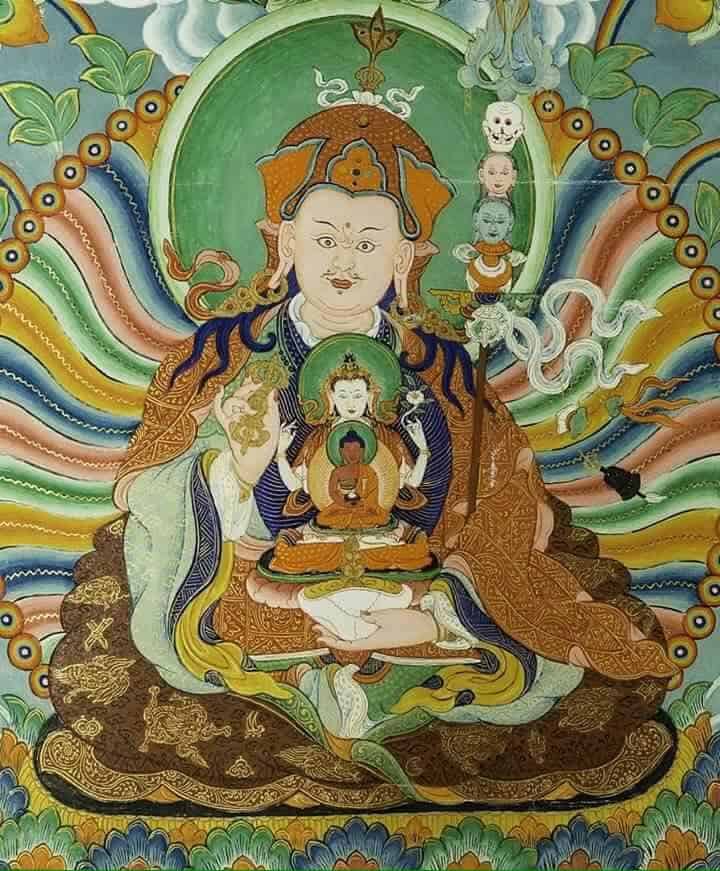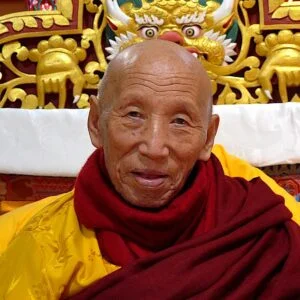How to Cultivate Devotion
In modern culture, we seem to have lost the traditional regard for our mentors. In the old days, you apprenticed to a trade. Your master was not necessarily the easiest person to get along with. But they did teach you a trade, a way to eat, and you felt sincere gratitude, even love. This gratitude for mentors was a part of every human civilization. I can remember some of the greatest professors I studied with in college would become almost teary eyed when they spoke of their mentors. Nowadays, relationships are much more transactional. Many people often feel that since their mentors are paid for their efforts there is no need to feel anything.
Yet, it should be completely natural that when you think of your spiritual teacher you have intense feelings of gratitude and love. For this is the guide who pointed out the nature of all phenomena, not just intellectually but experientially, and you understood something incredibly precious. Yet, almost every facet of modern society is working against this love— a youth-centric, celebrity worshiping, what can you do for me tomorrow, super freaking-fast moving, transactional culture of today. So we need to spend time cultivating.
Three Ways of Cultivating Devotion
Traditionally, we talk about three ways of cultivating devotion: ordinary, middling and supreme.
The ordinary way to cultivate devotion is to remind ourselves again and again about the great kindness of our teacher. We can consider that our guru is the embodiment of all the buddhas and bodhisattvas, manifesting as a spiritual friend to guide us. When we begin any practice, we can imagine our teacher in the sky before us. We supplicate the teacher, imploring them to show us our true nature. Then from their heart, rays of rainbow light stream out to touch our heart and then they dissolve into us. Our mind and their mind merge as one.
Usually the texts say that for beginners it is best to visualize the teacher as Guru Rinpoche, since we require an impressive being to offer our devotion to. More advanced practitioners with greater faith can see the teacher as they appear in life. But for me, although I have no real qualities or understanding, I find that it is more helpful to see the guru as they appear in life. For me that is the emotional hook. When I imagine that Kaybjé Tulku Urgyen is in the sky in front of me, in his ordinary robes the way he looked IRL, I melt.
Middling practitioners, possessing unshakable faith, will see their teacher as the spontaneously perfect mandala of whatever deity is their main practice.
Then to repeat what I heard from my teachers, supreme practitioners will just rest in the nature mind, the ultimate nature of reality itself, which is the dharmakaya guru— the wisdom that is uncovered when we merge our mind inseparably with our guru’s.
During the day, as we go about ordinary activities when good things happen, we can see it as coming from the blessing of the guru, the embodiment of the three jewels we take refuge in. When obstacles arise, we can think about how fortunate it is that our karma is ripening and, because of the blessing of the guru of the three jewels, we didn’t have to pay with our life. It’s said we should practice like that.
In our tradition the entire practice is one of devotion and compassion, the rising of uncontrived bodhi. When we hear “Guru Yoga” we think that it refers just to the fourth inner preliminary practice (ngöndro). But the whole of our practice is Guru Yoga.
The outer preliminaries of the four mind changings are not only to realize the importance of the path of dharma, but also to reflect on the need to follow a qualified spiritual guide. Each of the inner preliminaries, taking refuge & generating bodhicitta, Vajrasattva, mandala offering and Lamé Naljor (Guru Yoga) are also Guru Practices. The center of the refuge visualization is our guru inseparable from Guru Rinpoche. When we practice lojong, we do it with the refuge as our witness and at the end our guru dissolves into us. In this way, we generate the two ways that bodhi appears: Devotion upwardly towards all the great masters, and downwardly as compassion towards the suffering beings caught in samsara. For mandala offering, our object of offering is the guru, embodying all the buddhas and bodhisattvas. In Vajrasattva practice, it is the lama as Vajrasattva; when we appear as Vajrasattva, we appear as our guru appearing as Vajrasattva.
When we do our yidam practices, we visualize ourselves as our guru appearing as the deity. My teachers always said that when we do mahamudra or dzogchen meditation properly, our mind is inseparable from the mind of the guru and all the buddhas. In this last practice we take the uncontrived bodhi as the path, whereas in the previous practices, we use thoughts to generate an approximation of uncontrived devotion and compassion as a skillful means to discover the uncontrived.
So in this way, our practice relies on cultivating devotion—we practice like this in order to uncover our uncontrived love.
Devotion Doesn’t Mean You Always Have to Say Yes
When we read classic texts about how to behave around our root guru, it can sound quite extreme. Traditionally, it is taught that there are 3 ways to please and serve a teacher. The lowest way is to offer your wealth, the middling is to serve by offering your body and speech and the best is to put whatever teachings you received into practice one-pointedly, without regard for personal hardship. All this is really easy to write, but honestly it quite a challenge to actually do it.
These sorts of statements are actually the goal for how our relationship to our teacher should be. But it takes a lot of work and sincere practice to get there. And to really do any of those steps fully and properly you need a certain degree of realization. I have met very few ordinary people who practice while completely embracing the totality of what their teacher taught, let alone enduring any hardships. Even people that work full time for the dharma usually find that complete surrender to the demands of their guru is incredibly challenging, even Milarepa had trouble. And though we all give money to our guru, we still spend plenty of dough on personal indulgences. That’s the level we are at and IT’S OK!
I have an old friend who has traveled with her teacher as an attendant/secretary/sometimes cook for years. Once, when they stayed in my home, I came home from work and found her in tears.
“Rinpoche just scolded me for always doing exactly what he says!” she blurted out as I walked into the room. “All the texts say we should surrender to the Guru and serve him and never displease him. So what have I done wrong? What am I supposed to do?”
A day or two later my friend was not only over her dismay, but literally beaming. She told me about how she realized that Rinpoche had many students who would love to travel with him. She said because she has self-esteem issues, she always assumed that Rinpoche selected her for ability to be subservient. It never occurred to her that he might have wanted her to actually think for herself. My friend was actually a pretty smart person, and it seemed pretty obvious that her intellect and ability to get things done without drama, was certainly a big reason Rinpoche liked to bring her along.
We have to understand that devotion and surrender is something we work on, cultivate, we shouldn’t just do whatever we think the texts says, because our relationship with our teacher is dynamic not static like a text.
“No” can be an expression of devotion. Normally when we say no, we have a fair amount of energy behind it. The person is asking something of us we can’t or don’t want to give. If they crossed some sort of boundary, asking us for money or a lot of our precious time, we might even begin to go into a mental loop about how wrong and bad the request is. When it’s our spiritual master asking, it’s probably pushing our buttons and so it’s easy to get into a self-righteous overdrive just to manifest the confidence to say no. But instead we can stay open, vulnerable and explain gently and lovingly where we are at. Out of devotion we offer our resistance. It’s not normally how we operate, and so an honest loving “no” can become a kind of meta surrender.
For years I wanted to do a long retreat but my teachers kept asking me to wait. Finally, I was advised by one of my teachers to attend a 3 year retreat being led by another of my teachers. The retreat leading Rinpoche was in my home and we were enjoying a cup of tea on the patio. Rinpoche was asking me if I was ok giving up my career for a few years. I told him that it was true that I was leaving a lot of money on the table by leaving my career, but I was ready to do retreat. Rinpoche responded by saying, “Oh that’s too much you should stay home, you have an important career and can retire early and do retreat then.” I was really unhappy to hear this. I blurted out, ”No way! I have been waiting for more than ten years and finally it’s all happening, I can’t miss it!” Rinpoche’s smile just kept widening. He was testing me. Sometimes, it’s hard to fathom what the guru is really asking of us, it’s best to be authentic.
The practice of cultivating devotion is challenging and the process can be messy. We need to be gentle with ourselves. The point isn’t to have a set of rules about when to say yes or no, but to figure out how to be as authentic, vulnerable, and responsive as we are capable of being in any given moment. We don’t have to make ourselves go where we aren’t ready to go. It’s just like although Buddha fed himself to a lioness in a previous life it doesn’t mean that we should. We don’t have to force ourselves to live up to someone else’s ideals about devotion; devotion is about not being deceitful or hiding, and flexibly trusting a process rather than living up to a result we may not have realized personally yet. Also, if upon reflection you feel you could have done it differently, don’t waste time with regrets or beating yourself up.
Cultivating devotion is an opportunity to learn, about ourselves, and about our fundamental nature, and we likely won’t get everything right the first time anyway. It’s just like any other practice, some days we seem to be in the groove and some days it seems like we aren’t. We just need to keep trying.
part 1 is here
part 3 is here










Responses
Thanks so much for this and previous article in Devotion. So helpful and so clearly explained. Sometimes I get a little confused as to the form to be visualized..Guru Rinpoche or the physical form of the guru.
[…] part 2 is here […]